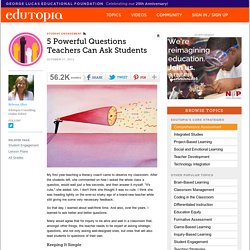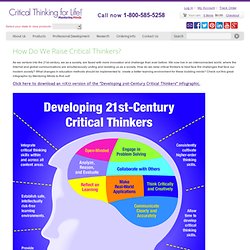

5 Powerful Questions Teachers Can Ask Students. My first year teaching a literacy coach came to observe my classroom.

After the students left, she commented on how I asked the whole class a question, would wait just a few seconds, and then answer it myself. "It's cute," she added. Um, I don't think she thought it was so cute. I think she was treading lightly on the ever-so shaky ego of a brand-new teacher while still giving me some very necessary feedback. So that day, I learned about wait/think time. Many would agree that for inquiry to be alive and well in a classroom that, amongst other things, the teacher needs to be expert at asking strategic questions, and not only asking well-designed ones, but ones that will also lead students to questions of their own.
Keeping It Simple I also learned over the years that asking straightforward, simply-worded questions can be just as effective as those intricate ones. . #1. This question interrupts us from telling too much. . #2. . #3. . #4. . #5. How do you ask questions in your classroom? 8 Things Everybody Ought to Know About Concentrating - StumbleUpon. “Music helps me concentrate,” Mike said to me glancing briefly over his shoulder.

Mike was in his room writing a paper for his U.S. History class. On his desk next to his computer sat crunched Red Bulls, empty Gatorade bottles, some extra pocket change and scattered pieces of paper. In the pocket of his sweat pants rested a blaring iPod with a chord that dangled near the floor, almost touching against his Adidas sandals. On his computer sat even more stray objects than his surrounding environment. Mike made a shift about every thirty seconds between all of the above. Do you know a person like this? The Science Behind Concentration In the above account, Mike’s obviously stuck in a routine that many of us may have found ourselves in, yet in the moment we feel it’s almost an impossible routine to get out of. When we constantly multitask to get things done, we’re not multitasking, we’re rapidly shifting our attention. Phase 1: Blood Rush Alert Phase 2: Find and Execute. Developing 21st Century Critical Thinkers. As we venture into the 21st century, we as a society, are faced with more innovation and challenge than ever before.

We now live in an interconnected world, where the Internet and global communications are simultaneously uniting and isolating us as a society. How do we raise critical thinkers to best face the challenges that face our modern society? What changes in education methods should be implemented to create a better learning environment for these budding minds? Check out this great infographic by Mentoring Minds to find out! Click here to download an 11X17 version of the "Developing 21st-Century Critical Thinkers" infographic. Embed This Image On Your Site (copy code below): <div style="clear:both" _mce_style="clear: both;"><a href=" _mce_href=" align="center" src=" _mce_src=" title="Developing 21st Century Critical Thinkers" width="900" height="5077" border="0" /></a></div><br/><br/><div>Courtesy of: <a href=" _mce_href=" Minds</a></div>
Ramsey Musallam: 3 rules to spark learning. 6 types of Socratic Questions. 249 Bloom's Taxonomy Verbs For Critical Thinking. Bloom’s Taxonomy’s verbs–also know as power verbs or thinking verbs–are extraordinarily powerful instructional planning tools.

In fact, next to the concept of backwards-design and power standards, they are likely the most useful tool a teacher-as-learning-designer has access to. Why? They can be used for curriculum mapping, assessment design, lesson planning, personalizing and differentiating learning, and almost any other “thing” a teacher–or student–has to do. For example, if a standard asks students to infer and demonstrate an author’s position using evidence from the text, there’s a lot built into that kind of task.
First a student has to be able to define what an “author’s position” is and what “evidence from the text” means (Knowledge-level). Though the chart below reads left to right, it’s ideal to imagine it as a kind of incline, with Knowledge at the bottom, and Create at the top. Critical Thinking. Critical Thinking Index Page.